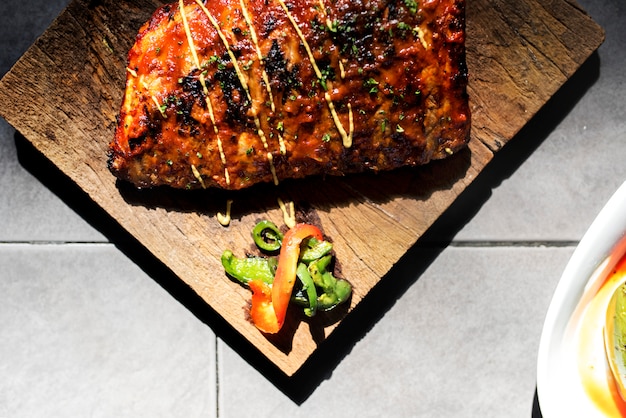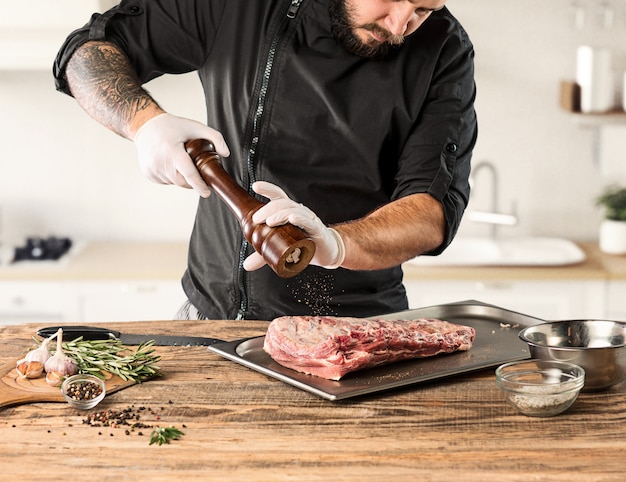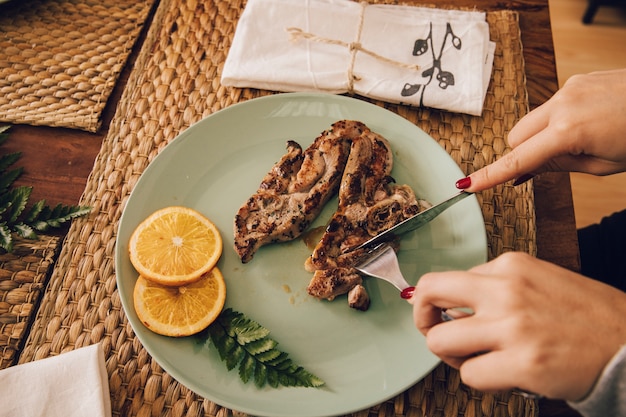There's something about a standing prime rib roast that just screams "special occasion." It's a centerpiece, a showstopper, a culinary masterpiece that elevates any gathering. It's a dish that demands attention and, when done right, delivers pure, unadulterated deliciousness. And trust me, I'm not just talking about the flavour, it's also about the experience. The anticipation, the aroma, the joy of sharing a feast with loved ones – it's all part of the prime rib experience.
Over the years, I've perfected my prime rib routine, learning a few tricks along the way, and I'm thrilled to share those secrets with you. We'll cover everything from choosing the right cut to nailing the perfect roast, creating the most delicious gravy, and even prepping some sides that will leave your guests wanting more. So, gather your ingredients, grab a comfy chair, and let's embark on this culinary adventure together.
Part 1: Choosing the Right Cut

The Key to a Magnificent Prime Rib: Understanding Your Options
The foundation of any exceptional prime rib is a good cut of meat. But with so many options available, how do you choose the right one? Here's a quick rundown to help you decide:
- Prime Rib Roast: The classic, often found in "bone-in" and "boneless" variations. They’re a go-to for most butchers and offer a great balance of flavor and tenderness.
- Rib Eye Roast: A smaller, more tender cut. Think of it like a giant steak – perfect for a smaller gathering or if you prefer a more delicate flavour.
- standing rib roast: Now we're talking! This is the crown jewel, featuring those beautiful, eye-catching ribs that add a touch of rustic charm. They’re ideal for feeding a crowd, and the bone provides added flavour and moisture.
- Bone-In vs. Boneless: This boils down to personal preference. Bone-in roasts offer deeper flavour and a more traditional presentation, while boneless roasts are easier to carve and often more uniform in cooking.
My Personal Preference: A Touch of Tradition
For me, there's just something about a bone-in standing rib roast. The bone, standing tall, is like a culinary trophy, a symbol of the majestic beast we're about to conquer. The flavour is undeniably richer, and the presentation is captivating. If you’re feeling fancy, ask your butcher to tie the roast with butcher's twine, creating a beautiful, even shape. It's an extra touch that elevates the dish.
Part 2: The Pre-Game: Preparing for the Big Roast

The Secret Weapon: Seasoning to Perfection
Don't underestimate the power of a simple seasoning. You can get fancy with spice rubs, but I'm a firm believer in letting the natural flavour of the prime rib shine through. My go-to seasoning is a generous sprinkle of kosher salt and a good grind of black pepper. The salt draws out moisture, enhancing the flavour, while the pepper adds a touch of warmth. I occasionally add a pinch of garlic powder for a hint of extra depth, but I prefer to keep it simple.
The Overnight Rest: Patience Pays Off
My grandmother always swore by letting the roast rest in the fridge overnight, and I've never looked back. This is a game-changer. The salt has time to penetrate the meat, tenderizing it and creating a beautifully seasoned crust. It’s a little bit of magic that leads to a more evenly seasoned roast with a delicious, crispy exterior.
Room Temperature is Key: Consistency is King
Before popping that prime rib into the oven, give it a chance to warm up. Take it out of the fridge and let it sit at room temperature for about an hour. This allows the meat to cook evenly, preventing the outside from getting overcooked before the inside reaches its desired temperature. It's a small step, but it ensures a consistently cooked, delicious roast.
Part 3: The Main Event: Cooking the Prime Rib

Low and Slow is the Way to Go: The Secret to Tenderness
Here's where the real magic happens. Prime rib needs to be cooked low and slow. This is the key to unlocking its tender, juicy potential. The general rule of thumb is to cook it at 225 degrees Fahrenheit (110 degrees Celsius) for about 15 to 20 minutes per pound. But remember, every oven is different, and each roast has its own unique personality.
Monitoring the Roast: The Temperature Game
The most important tool in your prime rib arsenal? A meat thermometer. It's your guide to culinary perfection. You can't rely solely on a timer. The key is to cook the roast to your desired level of doneness, and that's where the thermometer comes in.
Understanding Doneness: A Temperature Guide
Here's a quick guide to internal temperatures for different levels of doneness:
| Doneness | Internal Temperature |
|---|---|
| Rare | 125°F - 130°F (52°C - 54°C) |
| Medium-rare | 130°F - 135°F (54°C - 57°C) |
| Medium | 135°F - 140°F (57°C - 60°C) |
| Medium-well | 140°F - 145°F (60°C - 63°C) |
| Well-done | 145°F - 150°F (63°C - 66°C) |
The Rest: Patience is a Virtue
Once your roast reaches the desired temperature, don't rush into carving. Give it a chance to rest for at least 15 minutes, covered with foil. This allows the juices to redistribute throughout the meat, resulting in a supremely tender, succulent roast. It's like a little culinary reward for all your hard work.
The Roast's Last Stand: The Finish
For an extra touch of perfection, after resting, consider broiling the prime rib for a couple of minutes to achieve a beautiful, crispy crust. This isn't essential, but it adds a gorgeous caramelized finish and intensifies the flavour. Just keep a close eye on it and don't overcook it – a quick blast is all it takes.
Part 4: The Art of Carving
The Grand Finale: Carving the Roast
This is your moment to shine! Carving a prime rib is a skill, an art form that demands a sharp carving knife and a sturdy cutting board.
- Start at the Top: Carefully slice off the top layer of meat, just below the rib bones.
- Follow the Bone: Carve along the bones, working your way down the roast.
- Slice and Dice: Once you've separated the meat from the bone, slice it into nice, even pieces.
- Presentation Matters: Arrange the sliced meat on a platter, ready to impress your guests.
The Bones: Don't Forget the Flavor!
Don't discard those bones! They're a treasure trove of flavour. Simmer them in water with some vegetables for a few hours, and you'll create a delicious broth for soups, stews, or even a fantastic gravy. They’ll add a depth of flavour that’ll make you want to use them in everything!
Part 5: Accompaniments and side dishes
The Perfect Pairing: Side Dishes to Compliment the Feast
A prime rib roast deserves a supporting cast of delicious side dishes. You need dishes that balance the richness of the meat, complement its flavour, and offer a symphony of textures.
A Symphony of Flavors: Side Dish Suggestions
Here are some of my favourites, designed to create a culinary masterpiece alongside your prime rib:
- Roasted Vegetables: Brussels sprouts, carrots, parsnips, and potatoes all roast beautifully in the oven, infusing them with a smoky aroma and a touch of caramelization.
- Creamy mashed potatoes: A classic pairing that never fails. Whip up a batch of buttery, fluffy mashed potatoes for a comforting touch.
- green beans: A light and refreshing side dish, perfectly balancing the richness of the prime rib. Sauté them with garlic and olive oil, or steam them with a squeeze of lemon juice and butter.
- Asparagus: Roast it with a drizzle of olive oil, salt, and pepper for a simple, yet elegant side dish that perfectly complements the prime rib.
- Garlic Bread: Simple, satisfying, and a perfect complement to the richness of the meat.
Part 6: The Art of the Gravy
The Finishing Touch: A Rich Gravy to Elevate the Feast
A good gravy is more than just a sauce. It’s the final touch, the crowning glory, that elevates a prime rib roast from good to unforgettable. You can whip up a simple pan gravy using the drippings from the roast, or get a bit more creative.
Pan Gravy: Simple and Delicious
For a simple pan gravy, deglaze the roasting pan with a little wine or broth, scraping up any flavorful bits stuck to the bottom. Add a tablespoon of butter and a few tablespoons of flour, whisking it all together. Simmer until thickened, then strain it if you prefer a smooth texture. The drippings from the roast are the key to a truly flavourful gravy.
The Fancy Stuff: A Gravy Upgrade
Want to take your gravy to the next level? A dash of Dijon mustard or a splash of Worcestershire sauce adds a complex dimension of flavour. And, for the ultimate indulgence, make your own stock, but honestly, the drippings from the roast are enough to create a truly delicious, simple gravy. Keep it simple and let the natural flavours shine through.
Part 7: The Finishing Touches: Serving and Garnishing
Presentation Matters: The Final Steps
A prime rib roast deserves a grand presentation. You can carve it right at the table, impressing your guests with your culinary skills. Or, you can carve it in the kitchen and arrange the slices artfully on a platter.
Adding the Extras
Garnish your prime rib with a sprig of rosemary or thyme for a beautiful touch and a subtle hint of flavour. And, of course, no prime rib dinner is complete without a bottle of your favourite red wine. A full-bodied red, like Cabernet Sauvignon or Merlot, pairs perfectly with the richness of the roast.
Part 8: The Aftermath: The Delicious Leftovers
The Delicious Aftermath: prime rib leftovers
Don’t be sad when the feast is over. The best part of prime rib is the delicious leftovers. The possibilities are endless! You can slice it thinly and add it to sandwiches, salads, or pizzas. Dice it up for a hearty pasta dish, or enjoy it cold as a snack.
Reheating Your Prime Rib
If you want to reheat your leftover prime rib, the oven is your best friend. A low temperature is key to keeping it moist and flavorful. You can also reheat it in the microwave, but it's not the ideal method for preserving tenderness.
FAQs
1. What is the best temperature to cook prime rib?
Aim for a temperature between 225°F and 250°F (110°C - 120°C). Cooking low and slow allows the meat to cook evenly and retain moisture.
2. How long should I cook a prime rib roast?
A general guideline is 15 to 20 minutes per pound at 225°F. The exact time will vary based on the size and thickness of the roast. Always use a meat thermometer to ensure it reaches your desired level of doneness.
3. What is the best way to season a prime rib roast?
A simple combination of kosher salt and black pepper is the most effective way to enhance the natural flavor of the prime rib. You can add a touch of garlic powder or other spices, but keep it simple and let the meat take center stage.
4. What are some good side dishes for prime rib?
Roasted vegetables, mashed potatoes, green beans, asparagus, and garlic bread are all excellent choices. Choose side dishes that complement the richness of the meat and create a balanced, harmonious flavour profile.
5. What happens if I overcook my prime rib?
Overcooked prime rib will be dry and tough. To avoid this, monitor the internal temperature of the roast with a meat thermometer and take it out of the oven when it reaches your desired doneness. The rest method, letting it sit covered for 15-20 minutes before carving, also helps redistribute the juices and prevent dryness.
There you have it! My ultimate guide to perfectly cooked prime rib. Now go forth and impress your guests with a meal that's both delicious and unforgettable. Trust me, it's worth the effort, and your friends and family will be begging for seconds!
Everyone is watching

Corn on the Cob: The Ultimate Guide to Perfectly Cooked Ears
Healthy MealsAh, corn on the cob. Just the name evokes images of sunny days, barbecues, and that sweet, juicy flavour that ...

Perfect Pork Roast Oven Cooking Time: A Guide to Delicious Results
Healthy MealsThere's something truly satisfying about a perfectly roasted pork. The aroma alone is enough to make your mout...

Ham Cooking Time: How Long to Bake, Smoke, or Boil a Delicious Ham
Healthy MealsAh, ham. It's a classic, isn't it? A real crowd-pleaser, especially around holidays. And when done right, it'...

Scallops: The Ultimate Guide to Perfect Cooking
Healthy MealsAh, scallops. Those delicate, sweet, and utterly delicious morsels of the sea. They hold a special place in my...

Spaghetti Squash: The Ultimate Guide to Cooking and Serving
Healthy MealsRemember that time you saw spaghetti squash at the supermarket, looking all bumpy and strange, and thought, "W...
